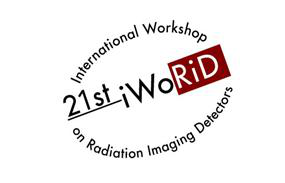Speaker
Description
Abstract: Timepix3 [1] detectors are hybrid pixel detectors developed within the Medipix3 collaboration. Their sensitive layer is divided into a square matrix of 256 x 256 pixel at a pixel pitch of 55 µm. They offer a data-driven readout scheme and can simultaneously measure the Time-of-Arrival (1.5625 ns binning) and the Time-over-Threshold in each pixel. Silicon is the most commonly used sensor material for typical Timepix particle tracking systems. Studies of Medipix and Timepix detectors with high-Z compound semiconductor materials (e.g. CdTe or GaAs) are mainly focusing on x- or γ-ray detection [2,3]. Despite disadvantages of the high-Z semiconductor materials compared to silicon (worse thermal stability, higher leakage currents, sensor inhomogeneities or charge carrier losses), particle tracking devices based on GaAs could profit from the higher electron mobility, the expected higher radiation tolerance and the higher stopping power.
In this contribution, we present a study of the performance of a Timepix3 assembly with a 500 µm thick chromium compensated GaAs sensor (ohmic contact) in particle beams at the Super-Proton-Synchrotron (SPS) at CERN.
In a first experiment, the device was irradiated at 60 degrees with 40 GeV/c pions. The acquired data were used to study the depth dependence of the drift time(s) and charge collection efficiencies (CCE) at bias voltages in the range from -25 V to -500 V (electrons were collected at the pixelated contact) (see the attached figure). A linear behavior of the drift time was found. At a bias of -25 V, drift times were below 22 ns, at -500 V drift times are below 4 ns. By comparing the drift time and CCE curves to theoretical expectations and taking the small pixel effect into account, an attempt is made to determine the charge carrier mobility µ$_{e}$ and the mobility-lifetime product µτ$_{e}$.
In a second experiment, a mixed radiation field was created by Pb beam (~330 GeV/c) impact on target. The Timepix3 assembly was exposed to the mixed ion beam at different angles (0 – 75 degrees wrt the sensor normal). Detector responses were studied in the form of the cluster size distributions, the energy spectra and energetic and temporal projections of single particles. Significant features of the heavy ions signature are presented and discussed. Peaks in the energy spectra are fitted by a linear combination of Landau distributions and the capability of separating different ion species as a function of impact angle is evaluated.
Figure: Measured drift times and charge collection efficiencies as a function of the interaction depth. For the study a Timepix3 with a 500 µm thick GaAs:Cr sensor was irradiated with 40 GeV/c pions at an angle of 60 degrees.
References:
[1] T. Poikela et al., JINST 9 C05013, 2014.
[2] C. Ponchut et al., JINST 12 C12023, 2017.
[3] T. Billoud et al., JINST 13 P04002, 2018.
